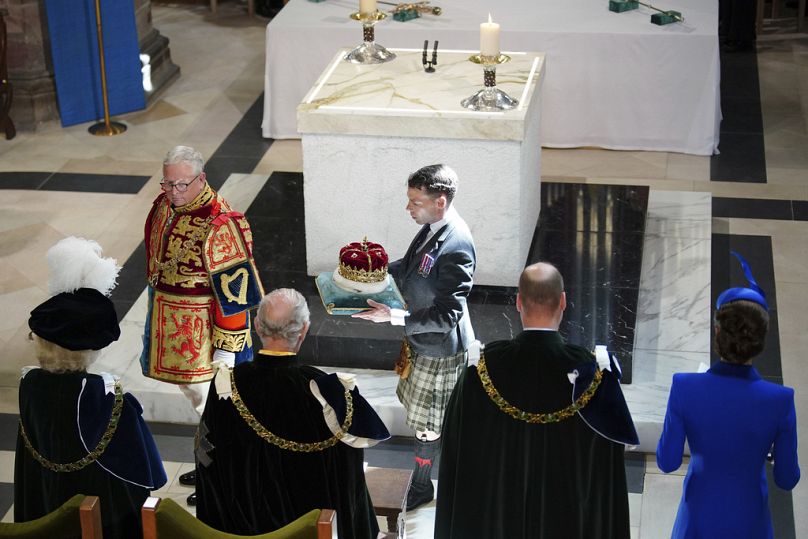Scotland marked the coronation of King Charles III by presenting him with the country's crown jewels.
King Charles III has been presented with the Honours of Scotland - the Scottish crown jewels in a ceremony in Edinburgh on Wednesday to mark his Coronation.
The proceedings included a grand procession, with horse-drawn carriages, mounted cavalry and a flyover by the Red Arrows, the Royal Air Force’s aerobatic display team, as well as the service of thanksgiving.
The British Monarch also received the new Elizabeth Sword, named after his mother and made to replace the one gifted to Scotland's James IV by Pope Julius in 1507 but now too fragile to use.
"The Honours of Scotland have immense historical significance, having been present at many major ceremonial events over the past 500 years," Scotland's First Minister Humza Yousaf said.
"Designed and crafted by some of Scotland's finest artisans, the Elizabeth Sword is a fitting tribute to the late queen as Scotland prepares to welcome the new king and queen."
The Stone of Destiny, the historic symbol of Scotland's monarchy and nationhood, was also moved to the cathedral for the service, for which the king commissioned five new pieces of music.
The event comes two months after the coronation of King Charles III at Westminster Abbey in London.
Two nations
Scotland's own version of the event marking the new monarch’s accession to the throne is a nod to the historical fact that England and Scotland had different monarchs until the crowns were united in 1603, after the death of Queen Elizabeth I.
Because the queen had no children, the crown passed to her cousin James VI who was already king of Scotland, uniting the two countries under a shared sovereign.
But Scotland remained independent until 1707 when lawmakers in both countries approved the Act of Union, which created the United Kingdom.
The presence of icons of Scotland’s nationhood in the ceremony is a mark of respect for a country that is fiercely proud of its history and where the desire of some for independence has never died.
What are the Scottish Honours?
The crown, sceptre and sword of state were once used to crown Scotland’s kings and queens. Made of gold, silver and precious gems, they are the oldest crown jewels in Britain.
The crown was made for James V who first wore it at the Coronation of Queen Mary of Guise in 1540. But it was Mary Queen of Scots who was the first to be crowned with it, along with the sceptre in 1543.
The crown itself weighs 1.59kg and is comprised of 94 pearls and 43 precious gems as well as a gold cross and gold and silver frame.
The sceptre is a symbolic ornamental rod held by the Scottish monarchs at their coronation and was a gift from Pope Alexander VI to James IV in 1494.
The three-foot-long sceptre is engraved with grotesques, urns, leaves, thistles and fleurs-de-lis.
Hidden away
Housed at the Royal Palace on the east side of Crown Square at Edinburgh Castle, the Honours of Scotland have survived troubled times.
They were last used at a coronation in 1651 when Charles II was crowned at Scone but were removed from the castle and hidden in 1651-60 to keep them from Oliver Cromwell's army.
Following the Act of Union between England and Scotland in 1707, there were rumours that the Honours were to be taken to England and melted down. (A post-union period song suggested they would be turned into a set of dildos for Queen Anne!)
To allay fears over the fate of the Honours, they were locked in a chest in the Crown Room in Edinburgh Castle and the room sealed.
In 1817 the Prince Regent issued a royal warrant authorising specified commissioners to break open the walled-up doorway of the Crown Room. The commissioners included the novelist and historian Sir Walter Scott.
The team rediscovered the Honours in 1818 – wrapped in linen, just as they had been left 111 years earlier - along with a mysterious silver wand, whose intended role has long been forgotten.












